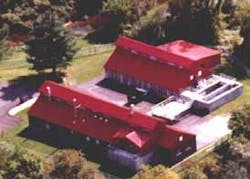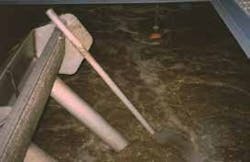The Village of Johnson Wastewater Treatment Facility (WWTF) was among the first in the state of Vermont to meet newly enacted secondary treatment requirements when it began operation in 1970. After legislative changes more than two decades later called for stricter discharge limits on phosphorous, ammonia, and residual chlorine, the Village of Johnson sought to increase the facility’s flow capacity, especially its ability to handle the high seasonal flows associated with storm events.
Solution
A Sanitaire ICEAS® (Intermittent Cycle Extended Aeration System) SBR (Sequencing Batch Reactor) was the core technology selected, and Johnson WWTF became the first plant to utilize SBR technology in Vermont. The project consisted of upgrading two aeration tanks, originally installed in 1970, by converting them to SBR process basins.
The ICEAS process involves three sequential treatment cycles in each SBR basin, fill and aerate, settle, and decant. During the fill and aerate cycle, air is introduced into the water to encourage bacterial growth. For the remainder of the fill cycle, no air is added, and the resulting anaerobic zone aids in biological phosphorous removal. During the settle cycle, the air remains off and the solids are allowed to settle in a perfect quiescent state and biodegradation of nitrogen is achieved. Finally, during the decant cycle, clarified wastewater is decanted from the basin by slowly lowering the baffled decant trough. When the first SBR basin begins the settle cycle, flow is shut off to that basin and directed to the opposite SBR basin to begin the fill/aerate cycle. The two SBR basins continue to alternate in timed sequences.
Residual biosolids generated by the biological process in the SBR basins are periodically pumped to two 20,000-gallon aerated sludge holding tanks for temporary storage. Liquid biosolids are pumped on a weekly basis to the belt filter press, where they are dewatered from 1 percent to 18 percent solids and transported to the biosolids compost facility.
Several treatment steps occur prior to and after the ICEAS SBR treatment step to ensure the high quality treated effluent water is being discharged into the Gihon River. Raw wastewater enters the WWTF in the pre-treatment area, where it flows through a screen to remove larger objects such as rags. Flow continues through a 30-foot long channel that allows heavier grit to settle out, and the influent flow rate is measured in a 3-inch-wide parshall flume with ultrasonic level measurement. Next a sewage grinder grinds all of the solids into small pieces and the flow continues into the influent pump station wetwell, where dual alternating variable speed centrifugal pumps move the flow into one of the two SBR basins for biological and secondary treatment. The effluent from the SBR process continues to two ultraviolet (UV) disinfection units and over a compound effluent flow-measuring weir.
The Sanitaire ICEAS SBR system continues to meet design effluent requirements on a year-round basis under varied flow, total phosphorous, and organic loading conditions.
Result
Biological phosphorous removal accomplished during the SBR fill cycle significantly reduces the amount of chemicals necessary to meet the new phosphorous effluent limits. The blower feedback control system uses dissolved oxygen probes to control the aeration blower runtime during the fill/aerate cycle, reducing the aeration electrical energy cost. The SBR system provides a level of safety by switching to storm cycle mode to provide additional capacity to accommodate high seasonal storm flows.
Editor's Note: Scranton Gillette Communications and the SGC Water Group are not liable for the accuracy, efficacy and validity of the claims made in this piece. The views expressed in this content do not reflect the position of the editorial teams of Water & Wastes Digest, Water Quality Products and Storm Water Solutions.

